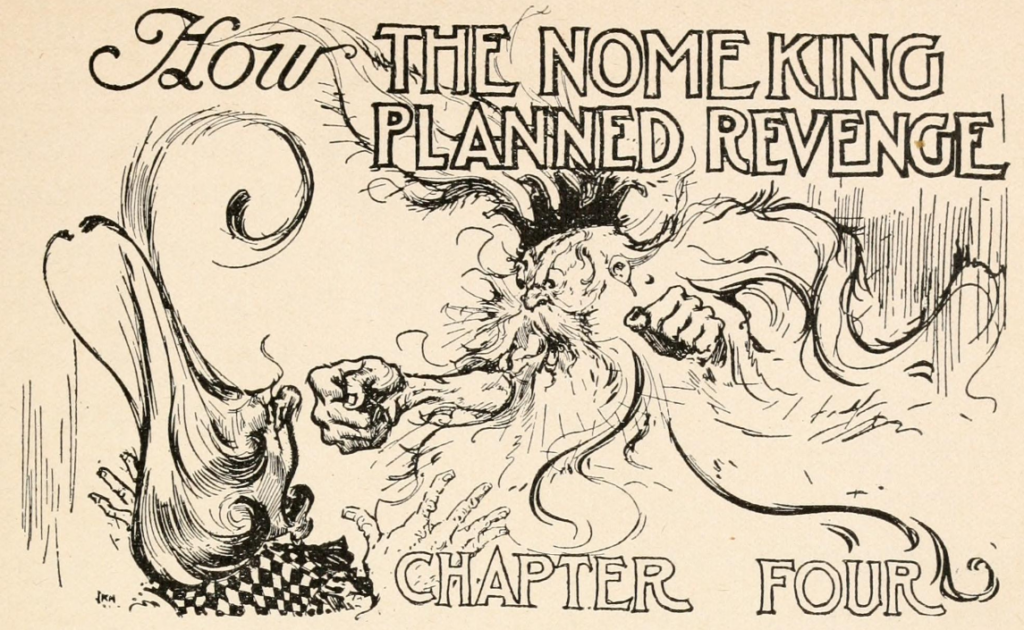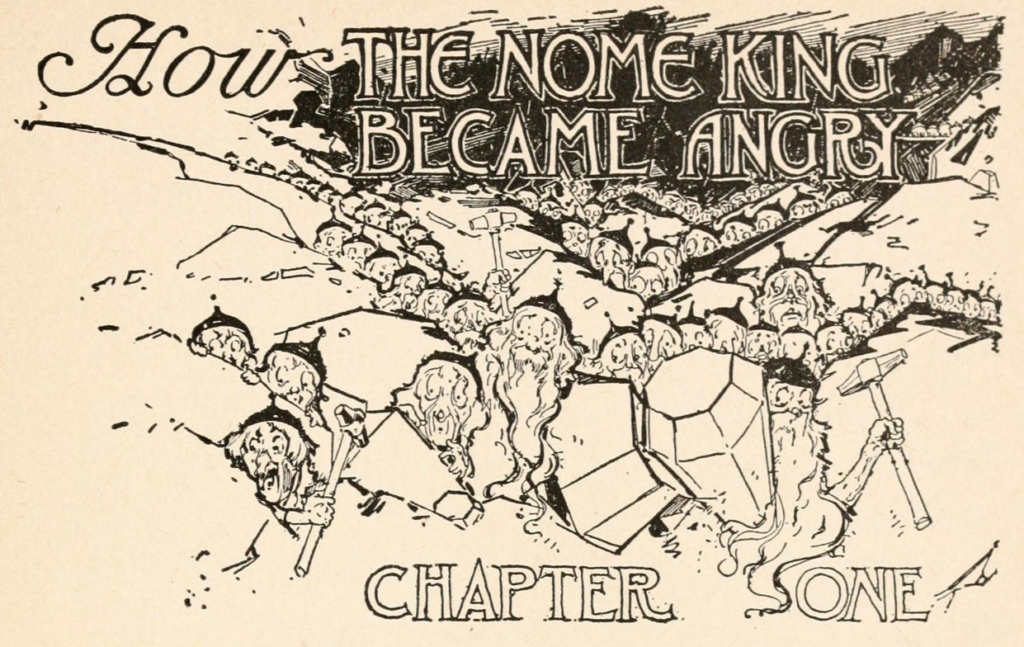2. A Bad Man and a Powerful Monarch: The Nome King Antithesis

The most major recurring villain of the Oz series is the Nome King, the “Metal Monarch,” a sadistic sorcerer who rules the Nome Kingdom in the Under World. Wagner takes him to embody “the force and violence that ensures power over others in the patriarchal system” (12). There are two Nome Kings in the series. The first is Roquat, renamed Ruggedo in Tik-Tok of Oz for an additional layer of confusion. The second is his replacement and former chief steward, Kaliko. For my purposes, all further mentions of “the Nome King” with no other context refer to Roquat/Ruggedo. He and the bellicose “evil powers” allied with him in The Emerald City represent an antithesis to Oz’s apparently utopian values and seek its destruction. Everything Oz and Ozma is, the Under World and the Nome King is not.
Where Oz is sunny and pastoral, the Nome Kingdom’s gloomy, militaristic Underground World or Under World (Baum uses both terms) is industrial. For a show of force in Ozma of Oz, the Nome King brings Ozma, Dorothy, and the Oz army to the Great Cavern:
A vast cave extended for miles and miles under the mountain, and in every direction were furnaces and forges glowing brightly and Nomes hammering upon precious metals or polishing gleaming jewels. All around the walls of the cave were thousands of doors of silver and gold, built into the solid rock, and these extended in rows far away into the distance, as far as Ozma’s eyes could follow them. (169)
The Nome King then blows a whistle to marshal his army of thousands of well-equipped soldiers from the doors, forcing “the busy workmen to abandon their tasks” (170). After boasting of their strength, the Nome King blows the whistle again, and the troops return to the barracks. In The Emerald City, Baum elaborates on the army, which is fifty-thousand strong. “When they were not required as soldiers all these Nomes were metal workers and miners, and they had hammered so much at the forges and dug so hard with pick and shovel that they had acquired great muscular strength. […] In time of war every Nome left his forge or mine and became part of the great army of King Roquat” (40).
The Ozite economy functions to produce “food and clothing and [houses] and furniture and ornaments and games” for the benefit of its people. The Ozites “[work] half the time and [play] half the time” without cruel overseers (Emerald City 31). In contrast, the Nomes perpetually labor in their King’s factories to produce “gold and silver and other metals which they conceal in the crevices of the rocks,” as well as “diamonds and rubies and emeralds, which they hide in the ground; so that the kingdom of the Nomes is wonderfully rich, and all [surface-dwellers] have of precious stones and silver and gold is what [they] take from the earth and rocks where the Nome King has hidden them” (Ozma of Oz, 130–131). Presumably the rest of the worker-soldiers’ output consists of the “swords and pikes” and “rock-colored uniforms” (Emerald City 40) that are used to uphold the ruler’s power and plunder other countries instead of to benefit each other. The Nomes also suffer to carry out their ruler’s vanity projects: “Ruggedo made the wonderful [Metal Forest] to amuse himself, as well as to tire out his hard-working nomes” (Tik-Tok 208).
Unlike the single policeman of Oz, who is afraid to load his gun, the Nome King’s army is “excellently drilled” and well equipped with armor, weapons, and electric lamps. Ozite leaders rule through consent—remember the Tin Woodman: “Every one love[s] him, and he love[s] every one” (Road to Oz 164)—whereas the Nome King rules through fear, for “no one love[s] him” (Emerald City 19). “[T]he nomes hated Ruggedo and there were so many thousands of the quaint little underground people that they could easily have rebelled and defied the King had they dared do so” (Tik-Tok 150). In The Emerald City and Tik-Tok of Oz, the Nome King routinely beats and hurls objects at his people, not only to punish disobedience but also because he enjoys hurting others for fun.

Kaliko mentions that the Nome King’s generals “get thrown away” frequently for displeasing him (Emerald City 40). Although Kaliko receives uncharacteristic mercy (minor physical violence), when General Crinkle tells him bad news, the Nome King indicates what “throwing away” might mean: “Please take General Crinkle to the torture chamber. There you will kindly slice him into thin slices. Afterward you may feed him to the seven-headed dogs” (41). Unlike the Ozites, the Nomes never enjoy themselves but perform compulsory industrial labor under threat of violent punishment. The Nome King’s use of a whistle parallels the Wicked Witch of the West, the archetypal bad ruler in the Oz novels, who summons her enslaved minions using a whistle in The Wonderful Wizard. The implication of the relationship between the ruler and his well-trained subjects is clear.
Rahn interprets the Metal Monarch as “a distinctly American kind of monarch—the industrial capitalist whose power resides in the monopoly he controls” (29), although her claim, and Baum’s own claim, that the Nome King wears no crown is only accurate to Ozma of Oz specifically (page 92 of Tik-Tok of Oz states he wears a crown carved from a single red ruby, and Neill illustrates him in a crown in both that book and The Emerald City). The Nome King presides over an imperialistic state and metallurgical industry, and Rahn claims “the faceless thousands of toiling Nomes resemble the miners and factory workers of industrial America” (ibid.).
